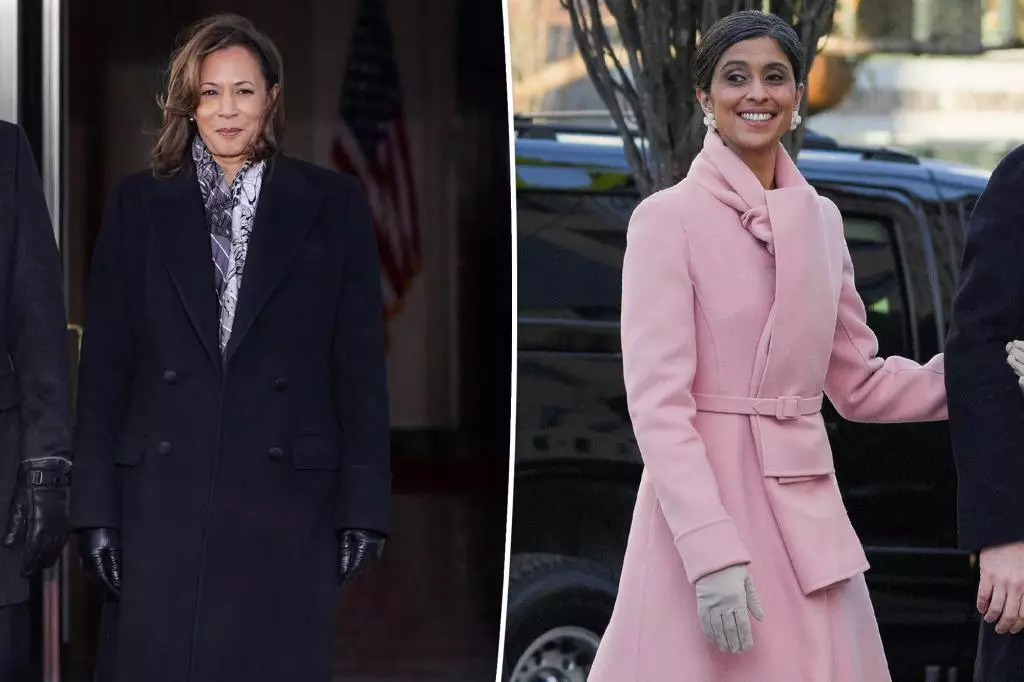In the realm of politics, attire often conveys more than mere aesthetics; it encapsulates sentiments, ideologies, and even the historical trajectory of a nation. Vice President Kamala Harris’s attendance at the inauguration of President-elect Donald Trump ended her personal campaign cycle but marked the continuation of a significant tradition: the peaceful transfer of power. In a tailored black coat, adorned with details that reflected both elegance and authority, Harris stood alongside her husband, Douglas Emhoff, signifying resilience and readiness to confront new political landscapes.
Harris’s sartorial choice was undoubtedly intentional. By opting for a classic and understated look, she communicated a willingness to respect the political processes and traditions that underpin democracy. The juxtaposition of her dark, minimalist palette against the vibrant bubblegum pink outfit worn by Second Lady Usha Vance further highlighted the diverse styles and expressions within the political sphere.
Throughout her four years as vice president, and indeed during her presidential run, Harris demonstrated a commitment to American fashion, frequently donning designs from notable American creators. From the works of Joseph Altuzarra to the vibrant and expressive styles of designers like Christian Siriano and Prabal Gurung, her fashion statements reflect not simply personal taste but a wider narrative supporting homegrown talent. Each outfit resonates with nuances of American culture while also pushing the envelope of traditional women’s fashion in political spaces.
A signature element of Harris’s wardrobe has been a simple string of pearls, which serves as a poignant homage to her sorority, Alpha Kappa Alpha. This accessory, reminiscent of the “Twenty Pearls” mythos of her organization, serves dual purposes: it anchors her look in cultural heritage while simultaneously projecting sophistication. Such thoughtful details highlight how fashion can carry deeply personal and political meanings.
The 2021 inauguration saw Harris make a bold statement by choosing a purple ensemble by designer Christopher John Rogers—a color often associated with bipartisanship—hence weaving together threads of cooperation amidst a politically fractured landscape. On subsequent occasions, she opted for striking pieces such as a black tuxedo coat paired with a sequined cocktail dress, crafted by the acclaimed Sergio Hudson. These choices not only showcase the diversity of American fashion but emphasize that Harris herself symbolizes a nuanced blend of tradition and innovation.
Her fashion inclinations often echo a broader narrative. For instance, during the highly publicized 2024 Democratic National Convention, Harris donned a ‘coconut brown’ Chloé suit, which seemed to nod both to Barack Obama’s iconic tan suit and to her own memorable ‘coconut tree’ speech—a clever interplay of past and present that conveys her understanding of political branding through style.
Harris’s collaboration with emerging designers such as LaQuan Smith cannot go unnoticed. Her choice of a striking black sequined gown for a Congressional Black Caucus Foundation event drew attention not only to her personal style but also to the importance of voicing support for young, Black designers. Smith’s description of the experience captures the essence of how Harris’s style can spur on diverse representation in a field that has often lacked visibility for designers of color.
This is particularly significant in a time when the fashion industry grapples with issues of representation and inclusivity. As Harris navigates her role, her choices become a testament to the potential of fashion to create dialogue about race, gender, and power dynamics within political arenas.
As we analyze the fashion choices of notable political figures like Kamala Harris, it becomes clear that such sartorial selections are not merely personal expressions but robust statements that engage with cultural narratives. They possess the power to inspire, provoke discussions, and even reshape perceptions about women in politics. The attention to detail, conscious choices, and the interplay of tradition and modernity found in her fashion reflections illustrate a profound understanding of the intricate relationship between style and substance.
Vice President Kamala Harris’s fashion reflects a deeper narrative of political engagement and cultural significance, finding a balance between respect for tradition and an eye toward progressive representation in the American fabric of leadership. As she continues to set new benchmarks within the political landscape, her style will undoubtedly continue to influence and shape the conversations surrounding women in positions of power.


Leave a Reply